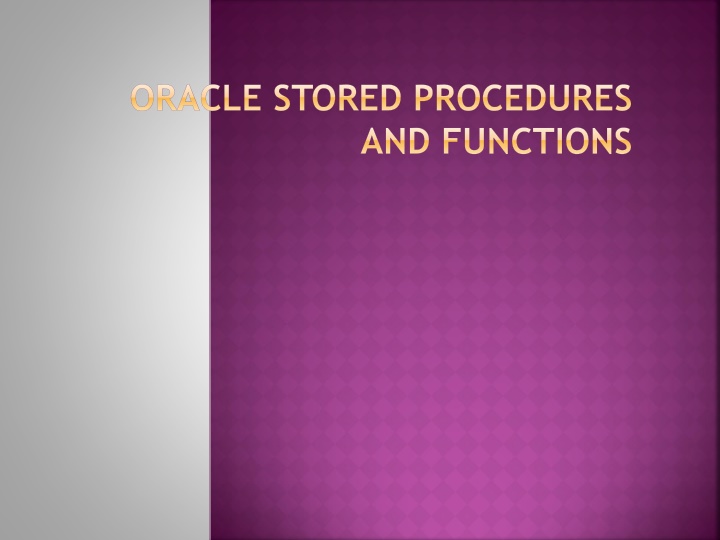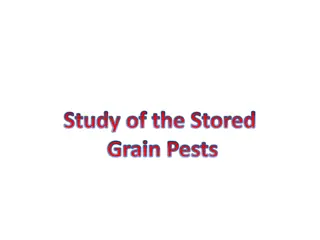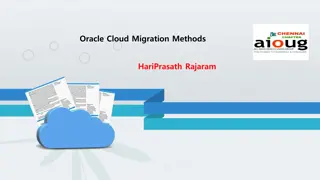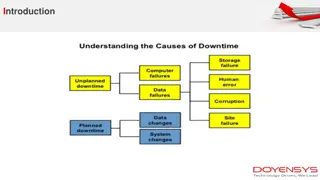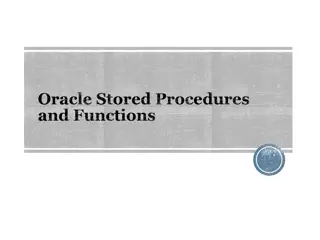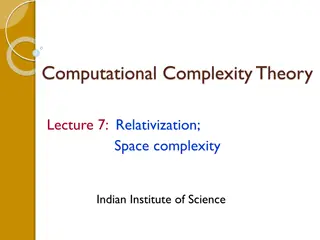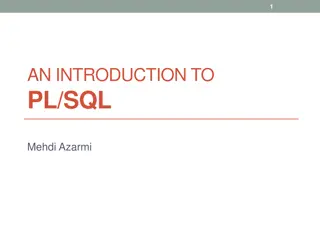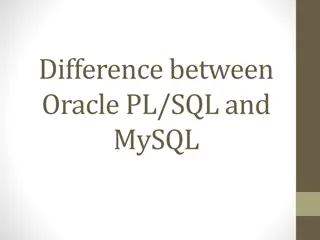Introduction to Oracle Stored Procedures and Functions
Explore the power of PL/SQL in Oracle by learning about stored procedures and functions. Discover how to create and use procedures, handle arguments, and execute them efficiently. Dive into the world of intricate data processing and modular business logic design with practical examples.
Download Presentation

Please find below an Image/Link to download the presentation.
The content on the website is provided AS IS for your information and personal use only. It may not be sold, licensed, or shared on other websites without obtaining consent from the author.If you encounter any issues during the download, it is possible that the publisher has removed the file from their server.
You are allowed to download the files provided on this website for personal or commercial use, subject to the condition that they are used lawfully. All files are the property of their respective owners.
The content on the website is provided AS IS for your information and personal use only. It may not be sold, licensed, or shared on other websites without obtaining consent from the author.
E N D
Presentation Transcript
ORACLE STORED PROCEDURES AND FUNCTIONS
WHAT CAN YOU DO WITH PL/SQL? Allows sophisticated data processing Build complex business logic in a modular fashion Use over and over Execute rapidly little network traffic Stored procedures Functions Triggers
STORED PROCEDURES Defined set of actions written using PL/SQL When called, the procedure performs actions Can be called directly from other blocks Two parts Procedure specification Procedure body
CREATING A PROCEDURE CREATE OR REPLACE PROCEDURE hello IS Greetings VARCHAR(20); BEGIN Greetings:= 'Hello World'; DBMS_OUTPUT.PUT_LINE(greetings); END hello;
ARGUMENTS A value can be passed to a procedure when it is called (input) Must specify datatype Example (not actually a procedure): Increase_salary_find_tax( increase_percent IN NUMBER:=7, sal IN OUT NUMBER, tax OUT NUMBER)
IN AND OUT Increase_salary_find_tax( increase_percent IN NUMBER:=7, sal IN OUT NUMBER, tax OUT NUMBER) IN means the procedure can read an incoming value from that parameter when the procedure is called OUT means the procedure can use that parameter to send a value back to what called it increase_percent has a default value of 7
CALLING A PROCEDURE Call it using the following commands set serveroutput on size 4000 EXECUTE hello; Another way to execute it is from a command block: BEGIN hello; END; To display output
ARGUMENTS Following is a procedure with arguments: CREATE OR REPLACE PROCEDURE increase (oldprice NUMBER, percent NUMBER := 5, newprice OUT NUMBER) IS BEGIN newprice:=oldprice+oldprice*percent/100; END increase;
CALLING A PROCEDURE WITH ARGUMENTS DECLARE price_increase NUMBER(6,2) := 20; newp NUMBER(6,2) := 0; BEGIN DBMS_OUTPUT.PUT_LINE('Current price: '|| price_increase); increase(oldprice=>price_increase,newprice=>newp); DBMS_OUTPUT.PUT_LINE ('Price after increase: '|| newp); END; We should see a new price of 21
PL/SQL FUNCTIONS Similar to procedure Function specification and function body A function returns a value Can be used within other SQL statements
CREATING FUNCTIONS CREATE OR REPLACE FUNCTION discount (amount NUMBER, percent NUMBER:=5) RETURN NUMBER IS BEGIN IF (amount>=0) THEN return (amount*percent/100); ELSE return(0); END IF; END discount; The IF-THEN construct allows for error checking
CALLING THE FUNCTION DECLARE current_amt NUMBER:=100; incorrect_amt NUMBER:=-5; BEGIN DBMS_OUTPUT.PUT_LINE(' Order and Discount'); DBMS_OUTPUT.PUT_LINE(current_amt || ' '|| discount(current_amt)); DBMS_OUTPUT.PUT_LINE(incorrect_amt||' '||discount(incorrect_amt)); END;
EXAMPLE Write a PL/SQL function that accepts price and onhand values, checks to be sure they are both greater than 0 and multiplies them together. If they are less than 0 return 0. CREATE OR REPLACE FUNCTION total_amount (price NUMBER, onhand NUMBER) RETURN NUMBER IS BEGIN IF (price>0 AND onhand>0) THEN return (price*onhand); ELSE return(0); END IF; END total_amount;
